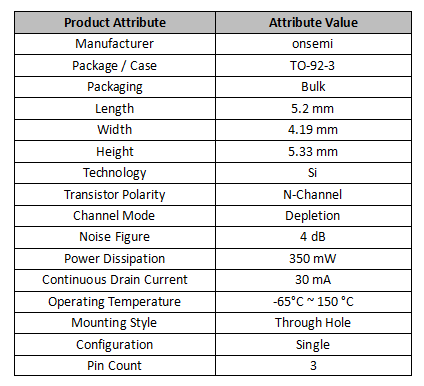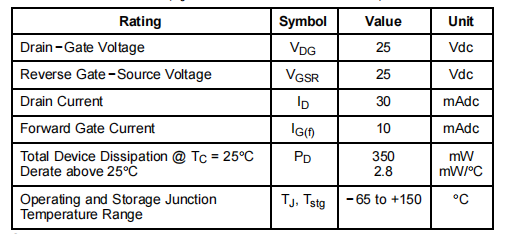2N5486 Transistor: Pin Configuration and Common Applications
The 2N5486 transistor is an N-channel JFET widely used in RF amplifiers, mixers, and switching circuits. This component is known for its high breakdown voltage, efficient power dissipation, and stable performance in high-frequency applications. With three main pins—source, gate, and drain—the 2N5486 is ideal for both analog and digital signal amplification. In this article, we will cover its features, assembly tips, common applications, and frequently asked questions to help you better understand how to use the 2N5486 effectively in your projects.Catalog

Comprehensive Examination of 2N5486 Transistor
The 2N5486 transistor is a silicon N-channel JFET used in RF amplifiers and mixers. It stays off at zero gate voltage and needs a positive gate voltage to conduct. With its high breakdown voltage, strong drain current capacity, and good power dissipation, the 2N5486 works well in VHF and UHF frequencies. It can handle up to 25 V and 30 mA while dissipating up to 350 mW, reducing the chance of overheating.
The 2N5486 can withstand high voltages, making it reliable under changing conditions. This protects it from failing at high voltages, making it dependable for RF circuits. Its capability to handle high drain current and dissipate power ensures stable performance, especially when used at VHF and UHF frequencies.
Substitute Options and Comparable Components:
• BF244B
• MPF102
• 2N5245
• 2N5246
• 2N5001
• 2N5001SMD
2N5486 Transistor Pinout, Symbol, and Footprint Explained

The 2N5486 transistor, a type of Junction Field-Effect Transistor (JFET), is widely used in electronic circuits for its efficient current control. It has three main pins: source, gate, and drain. Understanding these pins and how they function together is necessary for optimizing the transistor’s performance and versatility in different applications.
Source (Pin 2)
The source pin serves as the main outlet for current. It is typically connected to a reference point like ground to help stabilize the circuit. Grounding the source ensures steady voltage levels and helps maintain accurate transistor operation. Engineers often ground the source to set a stable operating point, ensuring consistent performance across various applications.
Gate (Pin 3)
The gate controls the transistor’s conduction state through small voltage changes. Insulated by a thin oxide layer, the gate allows the JFET to switch and amplify signals efficiently. Due to its high input impedance, the gate only requires a small current to produce noticeable changes in output, making it an effective control point in the circuit.
Drain (Pin 1)
The drain pin acts as the entry point for current. Current flows from the drain to the source, regulated by the voltage applied to the gate. This flow enables precise control over the transistor’s operation, following the core principle of how a JFET functions.
Technical Parameters of 2N5486 Transistor

Characteristics of the 2N5486 Transistor
Frequency Performance
The 2N5486 transistor performs exceptionally well in VHF (Very High Frequency) and UHF (Ultra High Frequency) ranges, making it a great choice for applications where accurate signal transmission is needed. In modern RF communication systems, the 2N5486 helps maintain signal clarity, making it valuable for high-speed data networks. Its ability to minimize signal loss and improve transmission quality makes it a go-to component for engineers working in these frequency ranges.
Current and Voltage Handling
The 2N5486 can handle a drain current of up to 30 mA and supports a breakdown voltage of up to 25 V. This capability allows it to deal with varying power levels without compromising performance. It is particularly useful in circuits designed for high-power or high-voltage applications. For example, in power amplifiers, the 2N5486’s ability to manage both high current and voltage ensures steady and reliable operation, even under challenging conditions.
Thermal Management
With a power dissipation capacity of 350 mW, the 2N5486 offers efficient thermal management. Its ability to dissipate heat effectively helps prevent overheating, which in turn boosts the reliability and lifespan of electronic circuits. Engineers often consider thermal behavior, as excessive heat can cause premature failure of components. The 2N5486’s strong thermal characteristics make it a good option for applications where temperature control is a priority.
Signal Integrity and Stability
The 2N5486’s high input impedance helps maintain signal integrity, preserving the accuracy and quality of transmitted signals. Its reliable junction structure ensures stable performance over long periods, making it suitable for sensitive electronic devices. This reliability is crucial in fields like medical devices or aerospace technology, where maintaining accurate signals and stable operation is critical for safety and functionality.
Versatility in Switching
The 2N5486 is versatile and works well for both NPN and PNP switching. Its versatility makes it suitable for a variety of high-frequency, high-power, and high-voltage applications. It is especially effective in RF amplifiers and receivers due to its low noise levels and high precision. This flexibility simplifies circuit design and reduces the need for multiple components, making it a practical choice for engineers looking to streamline their designs and reduce costs.
How to Use the 2N5486 Transistor Effectively
To operate the 2N5486 transistor effectively, applying the right gate-to-source voltage (VGS) is essential for controlling the current between the drain and source terminals. Adjusting this voltage allows for precise regulation of the transistor's conductivity, making it ideal for applications that require accurate current control. VGS is often fine-tuned using configurations like MOSFETs, enabling more control over the transistor's operating range based on the specific needs of the circuit.
Managing the current flow with the 2N5486 also involves using precision control mechanisms. Feedback loops and digital control systems are common methods. Feedback loops adjust VGS in real-time by monitoring the output current and making necessary changes, while digital control systems, typically used with microcontrollers, execute algorithms to set the gate voltage accurately. These systems offer fine control and allow for real-time adjustments, improving the transistor’s overall performance in demanding applications.
In practice, the 2N5486 is often used in amplification and switching circuits that require careful current regulation. Engineers test the transistor under various conditions to adjust VGS for specific needs. In analog signal amplification, getting the VGS setting right can reduce distortion and maintain signal clarity. Building prototype circuits and using tools like oscilloscopes and multimeters helps experiment with different VGS levels, allowing for optimization of the transistor’s performance through hands-on testing.
2N5486 Transistor Maximum Ratings

Application Scenarios of the 2N5486 Transistor
The 2N5486 transistor is used in various advanced electronic applications due to its versatile characteristics. Below are some key areas where this transistor demonstrates its strengths and practical use.
Wireless Communications
The 2N5486 is widely used in wireless communication systems for mixer and frequency conversion processes, which help enhance signal processing and improve overall system performance. Its application in RF amplifier designs is well-known due to its ability to handle high breakdown voltage and strong power dissipation. Devices operating at VHF (Very High Frequency) and UHF (Ultra High Frequency) frequencies benefit from these properties. Using the 2N5486 in such applications leads to clearer signals and more efficient transmission, making it a valuable component in modern communication systems.
Radar Systems
In radar systems, the 2N5486 is often used for signal amplification and noise reduction, both of which are essential for accurate radar signal detection and interpretation. Its high-frequency performance allows radar systems to function effectively under various environmental conditions, enhancing capabilities in both civil and military radar applications. By using the 2N5486, radar systems achieve better target detection and tracking accuracy, due to the transistor’s stability and consistent performance in high-frequency operations.
Electronic Warfare
In the field of electronic warfare, the 2N5486 is used for signal amplification and managing signal interference. This ensures clear signal transmission and reception even in challenging environments, improving communication channels and countering interference from electronic countermeasures. The transistor's reliable performance under pressure and its ability to reduce interference make it a preferred choice in high-stakes scenarios where dependable components are needed for successful operations.
Guide to Assembling and Connecting the 2N5486 Transistor
Before beginning assembly, it is necessary to verify that the 2N5486 transistor meets the project’s specifications. Check the component for any visible defects or damages, as this preliminary inspection can prevent potential issues and circuit failures. Once confirmed, place the 2N5486 transistor on the printed circuit board (PCB) with care, ensuring its legs are correctly aligned with other components. Following the schematic diagram during placement helps improve overall circuit performance and ensures solid connections, contributing to the durability of the circuit.
To manage heat effectively and prevent overheating, consider using heat sinks or thermal pads as needed. Thermal paste can also be applied to improve heat dissipation. Proper thermal management not only extends the life of the transistor but also maintains system stability under different operating conditions. During soldering, use suitable tools and techniques to attach the transistor to the PCB. Choose a soldering iron with an appropriate tip and temperature setting to avoid damaging the component. Apply the right amount of solder to create strong mechanical and electrical connections, as good soldering practices ensure reliable joins and stable circuit operation.
After completing the assembly, conduct thorough testing with tools like multimeters or oscilloscopes to check all connections and confirm proper functionality. If issues such as weak connections or cold solder joints are identified, address them immediately to ensure that the circuit operates as intended. Careful testing and adjustments help achieve the desired performance and maintain the integrity of the assembled device.
Frequently Asked Questions [FAQs]
1. What is the 2N5486?
The 2N5486 is an N-channel JFET commonly used to control current flow in various devices. It is often found in amplifiers, electronic switches, and different circuit setups. Its precise current control makes it ideal for applications that need accurate regulation. It is also known for its efficient switching speeds and dependable performance in handling electrical signals, making it popular in many technical fields.
2. What is the symbol for a 2N5486 in a circuit diagram?
In circuit diagrams, the 2N5486 is represented by a triangle symbol pointing inward, indicating the gate, with the drain and source terminals on either side. This standard symbol allows for quick identification and proper placement of the transistor in complex circuits. Using consistent symbols in schematics ensures clear communication and understanding among engineers and technicians.
3. What is the operating temperature range of the 2N5486?
The 2N5486 operates efficiently within a broad temperature range, from -65°C to 150°C. This wide range enables it to function well in various environmental conditions, from extreme cold to high heat. Its ability to perform across such a broad temperature span makes it suitable for use in industrial, commercial, and consumer electronics. The 2N5486's reliability and resilience in challenging environments further emphasize its durability.
4. What are the applications of the 2N5486?
The 2N5486 is used in a variety of applications, mainly in amplifier and switching circuits that require precise control. It is frequently used for signal amplification in both analog and digital circuits due to its low-voltage drive characteristics. It also performs well in low-power applications, making it ideal for battery-operated devices and other energy-efficient technologies. The versatility of the 2N5486 makes it a practical choice for many modern electronic projects.
5. How does the 2N5486 compare to other FETs like the 2N5458 or 2N3819?
The 2N5486 shares similarities with other N-channel JFETs such as the 2N5458 and 2N3819 but differs in some specifications. Each FET has unique maximum ratings and electrical parameters, so choosing between these components depends on the specific needs of the circuit. For instance, some applications might require a FET with lower noise levels or different operating characteristics. Analyzing the specifications and performance traits of each FET is necessary to select the right one for the intended application, ensuring that the component meets the design requirements.